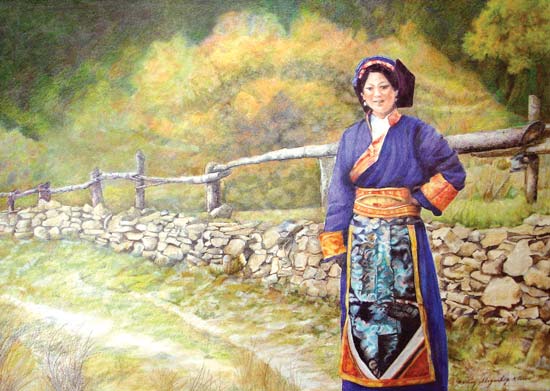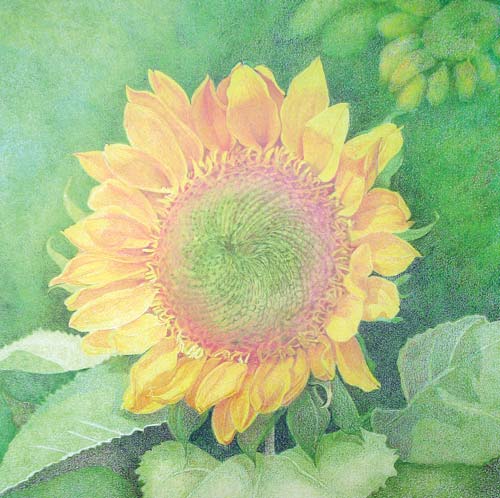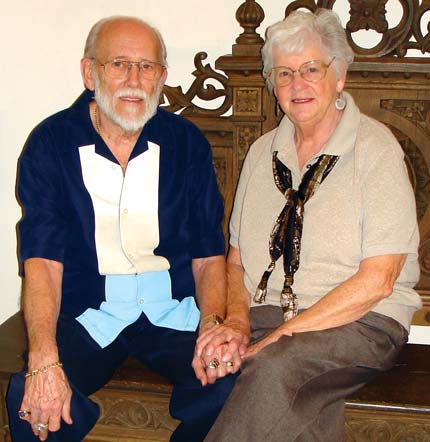Nan Klein’s colored pencil art has the rich colors of oil portraits and at the same time a subtlety of light only found in impressionist watercolors. Yet it’s the details in her creations that amaze viewers, who often ask “how did she do that?”

Nan Klein’s Oriental Lady took more than a year to complete.
 Nan has spent most of her life as an artist—from an outstanding student at the Art Institute of Chicago to an oil painter to a gallery owner and now as a popular art instructor in The Villages.
Nan has spent most of her life as an artist—from an outstanding student at the Art Institute of Chicago to an oil painter to a gallery owner and now as a popular art instructor in The Villages.
Her foray into colored pencils was as much a surprise to herself as it was to anyone who knew her work as a portrait painter. In addition to being an artist, she was the owner of the Petal Post Gallery in South Holland, Ill., when a customer brought in a piece of art to be framed and Nan didn’t know what the medium was.
“I still remember seeing that lovely portrait of an old-fashioned lady in a pink and blue hat,” Nan says. “I made up my mind that I was going to learn colored pencil technique, and then I would teach it when I retired.”
That was 15 years ago, and with her friend and fellow portraiture artist Donna Caputo, she took classes to learn more. Together the duo eventually wrote the teaching manual for a class in colored pencils that is still used in Nan’s classes at The Villages Lifelong Learning College.
Daughter Paula was the focus in this
colored pencil portrait.
“From the moment I picked up the pencil, I knew it was mine,” Nan says with a smile. “People who like detailed work like colored pencils.”
Her favorite subjects are portraits, although her latest creation is a detailed drawing that she simply calls Oriental Lady. Dressed in an exquisite costume, the subject is a bright focal point on a soft impressionistic landscape. Nan has worked on the piece on and off for more than a year.

The Fisherman is an award-winning colored pencil portrait of Paul’s brother.
“Every painting has to ‘read,’” she explains. “Just like a book, you can’t let the viewer’s eye run off the page. You must have composition.”
ALTHOUGH COLORED PENCILS have been around for many years, the medium has been recognized as a legitimate art form only for a couple of decades. The Colored Pencil Society of America was founded in 1990 and currently has about 1,600 members internationally, including Nan and Donna, who also lives in The Villages.
 Donna remembers that it was hard to enter shows with colored pencil art as recently as 12 or 13 years ago when she and Nan were beginning to work with the medium back in Illinois.
Donna remembers that it was hard to enter shows with colored pencil art as recently as 12 or 13 years ago when she and Nan were beginning to work with the medium back in Illinois.
“Now we not only enter, but we can stand up against watercolorists and oil painters,” says Donna, who exhibits nationally and is an active member of the Florida chapter of the Colored Pencil Society.
She describes Nan’s technique as more ‘light-handed’ than her own heavy-handed style that produces vivid colors.
“Nan has gotten more technical over the years,” Donna says. “She knows her color theory and uses a lot more colors than she did in the beginning.”
Both Donna and Nan have become award-winning colored pencil artists in numerous art shows around the country. Donna, who wanted to “do her own art thing,” turned over the teaching podium to Nan when the Kleins moved to The Villages in 2000.
Self-Portrait By Nan Klein.
Hundreds of newcomers to the medium have found it an easy one to learn, and most of the colored pencil artists in The Villages say they learned their techniques from Nan. Her classes consistently sell out. Her favorite student, though, is her husband of 57 years, Paul Brinkman Klein, who is a pen and ink artist in his own right.
The pair met while students at the famed Art Institute of Chicago and embarked on a life that has been surrounded by art ever since.
“I was going to day classes,” remembers Paul, “and I had to hang around and wait for Nancy to get to her late afternoon and evening classes.”

Sunflower uses three different colored pencil techniques.
AFTER GRADUATING WITH a degree in graphic design, Paul worked as an art director before opening The Creative Center, a graphic design studio and ad agency in Chicago. For over 30 years, he created logos and designs for a variety of clients in the Chicago area.
“Today, he does his own thing,” Nan says proudly. “He teaches one pen and ink class and sits in on most of my classes. He’s become quite good at adding color to his pen and ink drawings.”
While Nan’s drawings are more traditional, Paul’s work demonstrates an almost modern-art flair. His pieces are quite vivid and he says his four step process is a pencil sketch followed by ink and then colored pencil. The final pen and ink layer make his eye-catching pieces pop.
Together, Nan and Paul have collaborated on art used by little theaters and works displayed in local businesses, and they’ve served as art show judges. In addition, Paul has created a series of popular note cards featuring scenes from The Villages. Both Kleins are active members of The Villages Art League and the Visual Arts Association. The pair has two daughters and a granddaughter.
 It’s her granddaughter’s portrait that is Nan’s favorite piece of work.
It’s her granddaughter’s portrait that is Nan’s favorite piece of work.
“Every piece you create has some detail that is a problem or challenge to work out,” she says. “In my granddaughter’s portrait, it was the denim skirt. I had to get the folds in her skirt just right.”
NAN USES THREE TECHNIQUES in her colored pencil works to create various looks. The first is layering, which creates textures and can make the art look like different materials, including glass. Subsequent layers are added to obtain the color variations and shading.
The second is burnishing, which is done with a special burnishing pencil. Nan burnishes with white to make highlights.
Finally, she uses solvent with a cotton swab that literally melts the wax of the pencils and can create the look of a watercolor.
Paul’s portrait was one of Nan’s first oil pieces.
The Oriental Lady painting contains all three techniques, which is why it took more than a year for Nan to complete. If she only uses one technique, she can complete a piece in couple of weeks.
She also says that paper can make a huge difference in colored pencil art. The subject matter determines the kind of paper—whether smooth or textured—that the artist would use.

Paul and Nan Klein
If all these details sound too complicated for a colored pencil artist wannabe, they’re not, according to Nan. Her five-course series of classes begins with basic color theory, and by the fifth course many of the students are doing colored pencil portraits. More than 50 percent of the students who begin the first course sign up for the fifth course in the series.
“They begin by learning about color values,” Nan explains. “Then I show them techniques and tricks. It’s not hard.”
A Short History Of Colored Pencils
Many of us remember graduating from our boxes of Crayola Crayons in grammar school to sharper-pointed colored pencils. Today’s high-end artists’ pencils, such as Prismacolor and Derwent, are in a different class altogether.
Like graphite pencils, most colored pencils are encased in wood. The core is an extruded column of pigment and binders, usually a cellulose gum. The proportion of pigments, which are fairly expensive, separates artistic grade colored pencils from school-quality colored pencils that contain more filler material.
Colored pencils have been available since the early 19th century, but were not highly pigmented and did not contain as much wax as today’s products. The number of available colors was also limited. By 1924, however, the A.W. Faber company sold colored pencils in more than 60 colors for artistic use. That same year, Caran d’Ache, a leading manufacturer of artists’ colored pencils, was founded in Switzerland. In America, Berol Prismacolor introduced its pencils in 1938, touting velvety texture and a wide range of laboratory-tested colors.
Want To Know More?
Nan and Paul Klein may be reached at (352) 750-3123. Both exhibit regularly at La Galleria in the Hacienda Recreation Center in The Villages.






